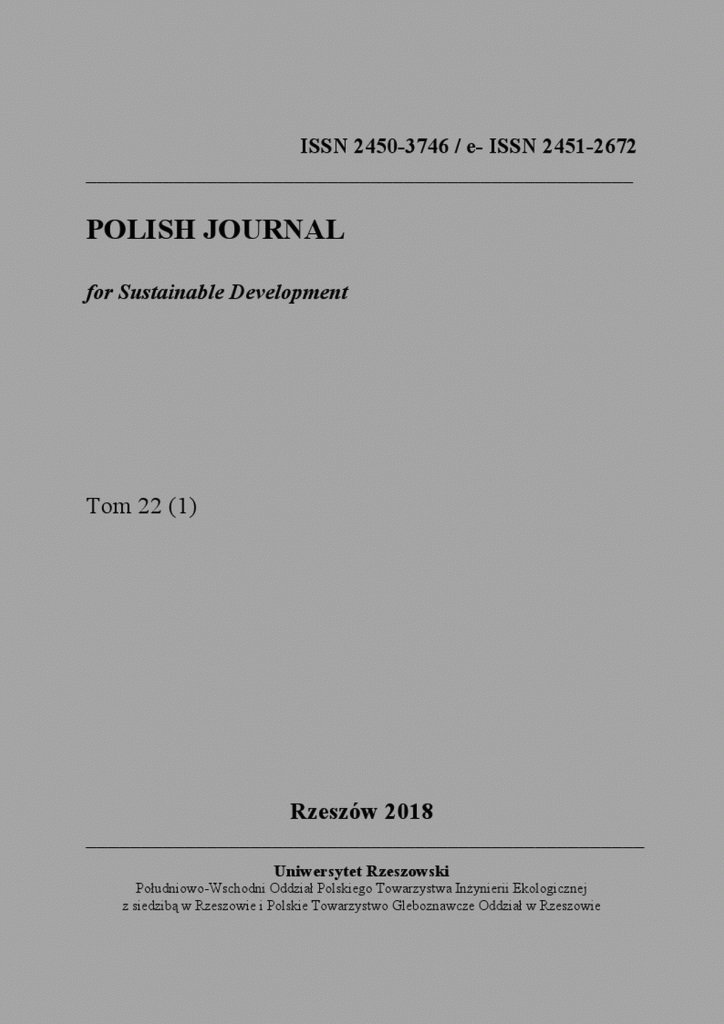Gospodarowanie odpadami a różnorodność biologiczna
DOI:
https://doi.org/10.15584/pjsd.2018.22.1.6Słowa kluczowe:
odpady, różnorodność biologiczna, ankietaAbstrakt
Choć po wejściu w życie zmian w systemie gospodarki odpadami komunalnymi, pomiędzy rokiem 2012 a 2016, zanotowano około 200% wzrost ilości odpadów zebranych selektywnie, nadal duża masa odpadów deponowana jest na składowiskach lub nielegalnych dzikich wysypiskach. Są zagrożeniem dla różnorodności biologicznej w ekosystemach. Szczególnie niebezpieczne wydają się być pod tym względem odpady opakowaniowe po napojach: plastikowe i szklane butelki, aluminiowe puszki itp. Tego rodzaju odpady nie tylko obniżają wartość estetyczną krajobrazu, ale jak wykazują liczni autorzy, stanowią również poważne zagrożenie dla bezkręgowców oraz małych kręgowców. Przeprowadzone badanie ankietowe analizowało wiedzę respondentów ankiety on line, na temat wybranych aspektów gospodarki odpadami i świadomości zagrożeń różnorodności biologicznej ze strony odpadów.
Downloads
Bibliografia
Brach M., Wiśniewski M. 2012. Przestrzenne aspekty dzikich wysypisk odpadów komunalnych w lasach na terenie Leśnictwa Stankowizna. Polskie Towarzystwo Informacji Przestrzennej. Roczniki Geomatyki. 55. 5. 37-45.
Convention on Biological Diversity. 1992. Convention on Biological Diversity. Secretariat of the Convention on Biological Diversity. Montreal. Canada [dok. Elektr.: http:// www.cbd.int/convention, data wejścia: 02.01.2018].
Diaz R.J., Rosenberg R. 2008. Spreading dead zones and consequences for marine ecosystems. Science. 321. 926-929.
Dmowska D., Warechowska M. 2009. The effect of the municipal waste landfill on the heavy metals content in soils. Contemporary Problems of Management and Environmental Protection. 4. 95-105.
Dobrzańska B., Dobrzański G., Kiełczewski D. 2012. Ochrona środowiska przyrodniczego. Wydaw. PWN. 459.
Foley J.A., Defries R., Asner G.P., Barford C., Bonan G., Carpenter S.R., Chapin F.S., Coe M.T., Daily G.C., Gibbs H., Helkowski J.H., Holloway T., Howard E., Kucharik Ch.J., Monfreda Ch., Patz J.A., Prentice G., Ramankutty N., Snyder P.K. 2005. Global consequences of land use. Science. 309. 570-574.
Foley J.A., Ramankutty N., Brauman K., Zaks D.P.M. 2011. Solutions for a cultivated planet. Nature. 478. 337-342.
Frączek K., Ropek D. 2017. Wpływ składowiska odpadów komunalnych na występowanie mezofauny glebowej. Woda-Środowisko- Obszary Wiejskie. 17. 2(58). 83-91.
Frączek K., Ropek D., Lenart-Boroń A. 2014. Assesment of microbiological and chemical properties in a municipal landfill area. Journal of Environmental Science and Health Part A: Toxic/ Hazardous substances and Environmental Engineering. 49(5). 593-599.
Formularz Google [dok. elektr: https://goo.gl/forms/PM3zE8R5sH9ZFIu42, data wejścia 18.11.2017].
Grodkiewicz P., Michniewska K., Siwiec P. 2015. Efektywność surowcowa w Polsce. Wpływ sprawnej logistyki odzysku na tworzenie gospodarki o obiegu zamkniętym. Difin.
Infrastruktura komunalna 2016. Gospodarka odpadami komunalnymi 2016. [dok. elektr.: http:// www.stat.gov.pl, data wejścia: 02.01.2018]
Kalda G., Wilk M. 2014. Analiza gospodarki odpadami przemysłowymi na terenie Podkarpacia. Journal of Civil Engineering, Environment and Architecture. XXXI. 64(4/14). 109-123.
Kostecka J. 2013. Retardacja tempa życia i przekształcania zasobów przyrody – wybrane implikacje obywatelskie. Inżynieria Ekologiczna. 34. 38-52.
Kostecka J., Koc-Jurczyk J., Brudzisz K. 2014. Gospodarka odpadami w Polsce i Unii Europejskiej. Gospodarka Odpadami i Ochrona Środowiska. 16 (1). 1-10.
Kulig A., Skalmowski A., Żurowski R. 2002. Procedura oceny efektów rekultywacji biologicznej terenów zdegradowanych. Problemy Ocen Środowiskowych. 2 (17). 30-36.
Kulik R. 2008. Odkrywanie natury. Praktyka głębokiej ekologii. 29. 1-71.
Manczarski P., Juda-Rezler K. 2010. Zagrożenia związane z zanieczyszczeniem powietrza atmosferycznego i gospodarką odpadami komunalnymi. Nauka. 4. 97-106.
Nycz-Wróbel J. 2012. Świadomość ekologiczna społeczeństwa i wynikające z niej zagrożenia środowiska naturalnego (na przykładzie opinii mieszkańców województwa podkarpackiego). Zesz. Nauk. Politechniki Rzeszowskiej. 286 (19/3). 64-76.
Pawul M., Sobczyk W. 2011. Edukacja ekologiczna w zakresie gospodarki odpadami jako narzędzie realizacji zrównoważonego rozwoju. Problemy Ekorozwoju. 6 (2). 147-156.
Raudsepp-Hearne C., Peterson G.D., Tengö M., Bennett E.M., Holland T., Benessaiah K., MacDonald G.K., Pfeifer L. 2010. Untangling the environmentalist's paradox: why is human well-being increasing as ecosystem services degrade? BioScience. 60. 576-589.
Sieja L. 2006. Charakterystyka odpadów komunalnych na podstawie badań w wybranych miastach Polski. Ochrona powietrza i problemy odpadów. 1. 1-7.
Siemiński M. 2008. Środowiskowe zagrożenia zdrowia. Wydaw. PWN, Warszawa. 660.
Skłodowski J. 2004. Giną w śmieciach. Echa Leśne. 4. 7-8.
Skłodowski J., Podściański W. 2004. Zagrożenie mezofauny powodowane zaśmiecaniem środowiska. Parki Narodowe i Rezerwaty Przyrody. 23 (2). 271-283.
Sonesson U., Björklund A., Carlsson M., Dalemo M. 2000. Environmental and economic analysis of management systems for biodegradable waste. Resources, Conservation and Recycling. 28(1-2). 29-53.
Tilman D., Balzer C., Hill J., Befort B.L. 2011. Global food demand and the sustainable intensification of agriculture. Proc. Natl Acad. Sci. USA. 108(20). 260-264.
Tomlinson I. 2013. Doubling food production to feed the 9 billion: a critical perspective on a key discourse of food security in the UK. J. Rural Stud. 29. 81-90.
Waldharadant R. 2003. Biodiversity and landscape – summary conclusion and perspectives. Agriculture Ecosystems and Environment. 98. 305-309.
Wilcove D.S., Koh L.P. 2010. Addressing the threats to biodiversity from oil-palm agriculture. Biodivers. Conserv. 19. 999-1007.
With K.A., King A.W. 2004. The effect of landscape structure on community self organization and critical biodiversity. Ecological Modelling. 179. 349-366.
Zhang Ch., Nie S., Liang J., Zeng G., Wu H., Liu J., Yuan Y., Xiao H., Deng L., Xiang H. 2016. Effects of heavy metals and soil physicochemical properties on wetland soil microbial biomass and bacterial community structure. Science of the Total Environment. 557 (558). 785-790.
Zmiana systemu gospodarki odpadami komunalnymi w Polsce w latach 2012-2016; [dok. elektr.: www.stat.gov.pl. data wejścia 27.12.2017].
Pobrania
Opublikowane
Numer
Dział
Licencja
Prawa autorskie (c) 2018 Polish Journal for Sustainable Development

Utwór dostępny jest na licencji Creative Commons Uznanie autorstwa – Użycie niekomercyjne – Bez utworów zależnych 4.0 Międzynarodowe.


